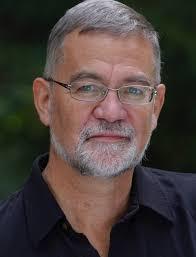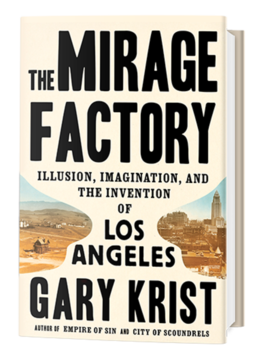Gary Krist ’79 Tells the Story of Los Angeles

Although the city was built on the backs of many, Krist highlights the biographies of three exceptional individuals whose careers helped shape the city to its modern form. William Mulholland, a self-taught engineer, pioneered a water project which lifted the city out of drought-ridden confinement; D.W. Griffith, a film expert who transformed the film industry, developed the motion picture to become the center of Los Angeles and American culture; and Aimee Semple McPherson, an evangelist who reinvented the religious landscape of the city. The stories of all three figures illustrate the remarkable innovation that took place in Los Angeles in the period between 1900 and 1930, ultimately giving birth to the city we all know today.
A combination of research and narrative, The Mirage Factory is an account of the implausible beginnings of Los Angeles, and the dreams of the figures who shaped it.

Opening Lines: “The gatehouse blew shortly after 1 a.m. — a powerful blast that ricocheted off the wall of mountains to the west and resounded across the dark, lonely valley. Another sound followed a moment later. It was less violent but more ominous: the low, rolling, slowly deepening roar of rushing water.
“Someone had bombed the Los Angeles Aqueduct. A case of stolen dynamite, fitted out with a blasting cap and a makeshift fuse, had exploded under the Alabama Gatehouse, located about 210 miles north of the city, near the remote town of Lone Pine in the Owens Valley. One of the building’s five spillgates — thick metal doors designed to release excess water from the aqueduct after heavy storms — had been ripped apart, allowing 200 cubic feet of water per second to pour uselessly down a spillway and out across the parched valley floor. By the time the aqueduct’s flow could be shut off at another gate some 20 miles north of the breach, over one 100 million gallons would be wasted — in one of the driest corners of the country, in the middle of one of the worst droughts in years.
“By the time Detective Jim Bilyeu of the Inyo County Sheriff’s Department arrived on the scene, a small crowd of Lone Pine residents had gathered near the still-smoking gatehouse. Some were actually applauding the destruction, pounding each other on the back in celebration. Hostility toward the aqueduct — and toward the distant, insatiably thirsty city that had built it — was widespread across the sparsely populated Owens Valley in 1976, and many locals felt that the L.A. Department of Water and Power (LADWP) had been dealt a well-deserved blow. ‘If I ever find out who bombed the gates,’ one man allegedly remarked, ‘I’ll buy him a steak dinner.’
“This resentment was not new. Ever since the city built the aqueduct in the early 1900s, tensions between Los Angeles and the Owens Valley had been high. Many in the valley felt that the city had stolen their water, acquiring property and water use rights under false pretenses and then greedily drawing off the flow of the Owens River, allowing L.A. to flourish while the local economy languished. This valley — despite being a ‘Land of Little Rain,’ as one local writer had famously called it — was at one time an aspiring agricultural region. In the decades around the turn of the century, plentiful water from the Owens River, which gathered the runoff of 40 mountain streams in the nearby high Sierra Nevada and channeled it through the otherwise arid region, had sustained livestock and irrigated fields all up and down the 100-mile-long valley. At its southern end, the river had even broadened out into a large, shallow lake, where local residents could go boating and migrating waterfowl could cavort among swaying reeds.
“Then in 1913, the aqueduct had come, and most of that water had been taken away to nurture the growth of far-off Los Angeles. The people of the Owens Valley had rebelled. Several times during the drought-stricken 1920s, they had responded with dynamite, bombing the aqueduct at various points along its 233-mile path. Relations between city and valley remained poisonous for years. Eventually, though, the parties came to a compromise, declaring an uneasy truce, and the bombing stopped.
“Now, decades later, the LADWP was trying to wring yet more water from the valley. To meet the city’s needs during this latest drought, they had begun intensive pumping of the valley’s groundwater basin, threatening to destroy what was left of the region’s vegetation and turning the lower Owens River into nothing more than a dry ditch, winding down the valley to a barren alkaline plain that had once been a lake. No wonder, then, that those people standing around the ruined gatehouse were applauding the bombers. As one valley resident later admitted, ‘We’d all thought about doing something like that — but they actually hauled off and did it. So we ... clinked beer bottles in their honor.’
“Not that this latter-day echo of the 1920s bombing campaign caused Los Angeles much harm. A series of reservoirs much closer to the city held enough water in reserve to ensure that Angelenos suffered no shortages or interruptions in their service. Within a few days of the sabotage, the shattered spillgate was already repaired and the aqueduct was flowing again. County and federal authorities lost no time in ferreting out the perpetrators: two young locals who, after a few beers, had decided that they were fed up with the city’s water-grabbing and decided to do something about it. For the bombing of the Alabama Gatehouse, they were eventually indicted, tried, and sentenced to minor jail terms. After doing their time, they were allowed to fade into obscurity.
“It was a pattern that had developed over many years: Los Angeles siphoning off resources, industry, and population from elsewhere to satisfy its insatiable desire for growth. The city’s leaders had turned this process into something of an art form, getting what was needed to prosper by whatever means necessary. Water was only one of the city’s requirements, and the stagnation of the Owens Valley only one of the consequences of this voracity.
“The Owens Valley, meanwhile, just grew drier, and — as it had for decades — the great megalopolis to the south just grew bigger and thirstier.”
Reviews: “Gary Krist is a city whisperer as well as a brilliant writer. He shows the soul of L.A. through the lives of three dreamers who helped conjure out of a sleepy town the foundation for an improbable and profoundly influential metropolis. A vastly entertaining and informative book, even for someone who has spent more than half his life here.” — Eric Lax, author of Start to Finish











1 Response
Margaret Romero
5 Months AgoInteresting Writer
Looking forward to being introduced to this interesting writer.